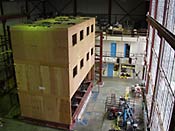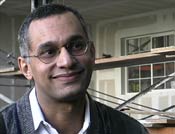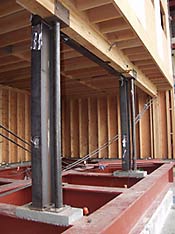|
 |

VIDEOS:
Three-story apartment building shakes, rattles, and
rolls during a seismic test that simulated a 1994 Northridge-scale
earthquake
|
| |

VIDEO:
UC Berkeley civil engineering assistant professor Khalid
Mosalam describes the rationale for the test.
|
| |

A
new steel frame, designed to resist seismic forces,
was installed to simulate the typical way buildings
like this have been retrofitted. Such retrofits often
include steel beam supports.
|
Seismic
sensor technology could prove useful to highrise buildings throughout
California
21
December 2001
By
Sarah Yang, Media Relations
BERKELEY
— New sensor technology developed at UC Berkeley
may soon help make buildings safer, as demonstrated by December
earthquake simulations at the campus's Richmond Field Station.
In addition
to 200 conventional sensors hardwired to the full-scale woodframe
building to measure acceleration, 50 remote accelerometers
developed by campus researchers were installed in key support
points throughout the structure.
"After
an earthquake, structural and civil engineers would traditionally
go into a building to inspect it for safety," said Steven
Glaser, associate professor of civil and environmental engineering
at UC Berkeley. "With these sensors, engineers could evaluate
a building's structural integrity in near-real time while
standing safely outside."
During
the simulations, data from the remote sensors were downloaded
onto a laptop computer after each shake test. The information
gathered indicated the force with which certain structural
points had been subjected.
Glaser
and UC Berkeley civil engineering students Judy Mitrani, a
doctoral candidate, and Jan Goethals, an undergraduate, have
been adapting the sensors to measure acceleration, a key indicator
of how much force a structure has undergone during an earthquake
or other disaster.
Their research
is part of UC Berkeley's Center for Information Technology
Research in the Interest of Society (CITRIS), an ambitious
initiative that brings together faculty from four UC campuses,
the state and private industry to develop innovative technology
capable of tackling some of society's most pressing problems.
The sensors
used in the test are an application of wireless sensor networks
developed by associate professor Kris Pister and professor
David Culler, both from UC Berkeley's Department of Electrical
Engineering and Computer Science.
The beauty
of the remote sensors, said Glaser, is they eliminate the
"spaghetti wires" required for conventional sensors and are
10 times cheaper, making them more useful and practical for
placement in new building construction.
State law
now requires a minimum of two accelerometers to be installed
during the construction of new buildings at least five stories
tall.
"Two sensors
on a building are better than nothing, but to truly get useful
information, engineers would want at least one sensor for
each floor," said Glaser. "Because the sensors we're developing
are so much cheaper and at least as accurate as conventional
accelerometers, builders will actually be able to afford high-quality
data."
Glaser
has been working with San Jose-based Crossbow Technologies,
Inc., to create a commercially available product by next spring.
Related
Story:
Shaking
the foundations of the building industry: UC Berkeley engineers
test retrofitted woodframe structure
|